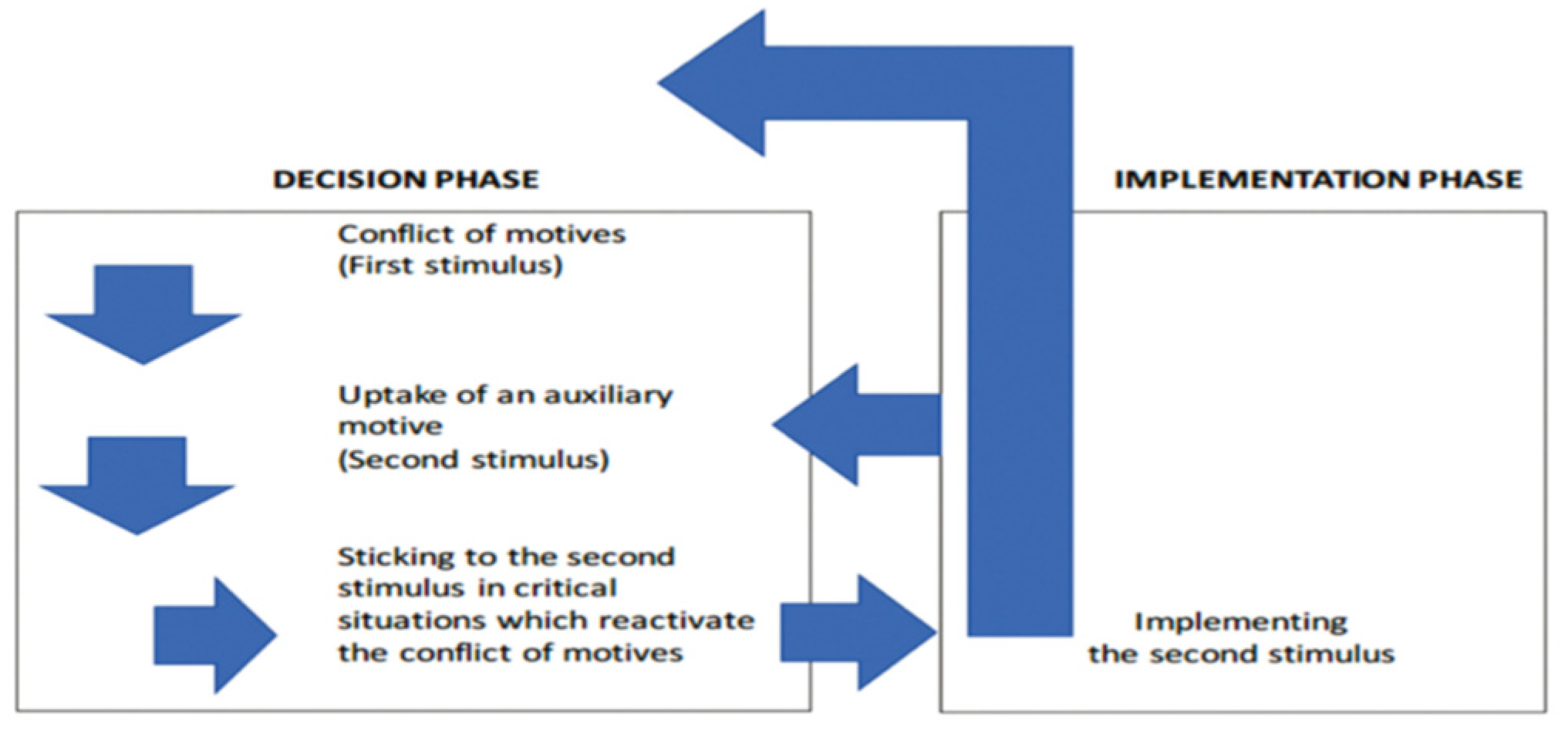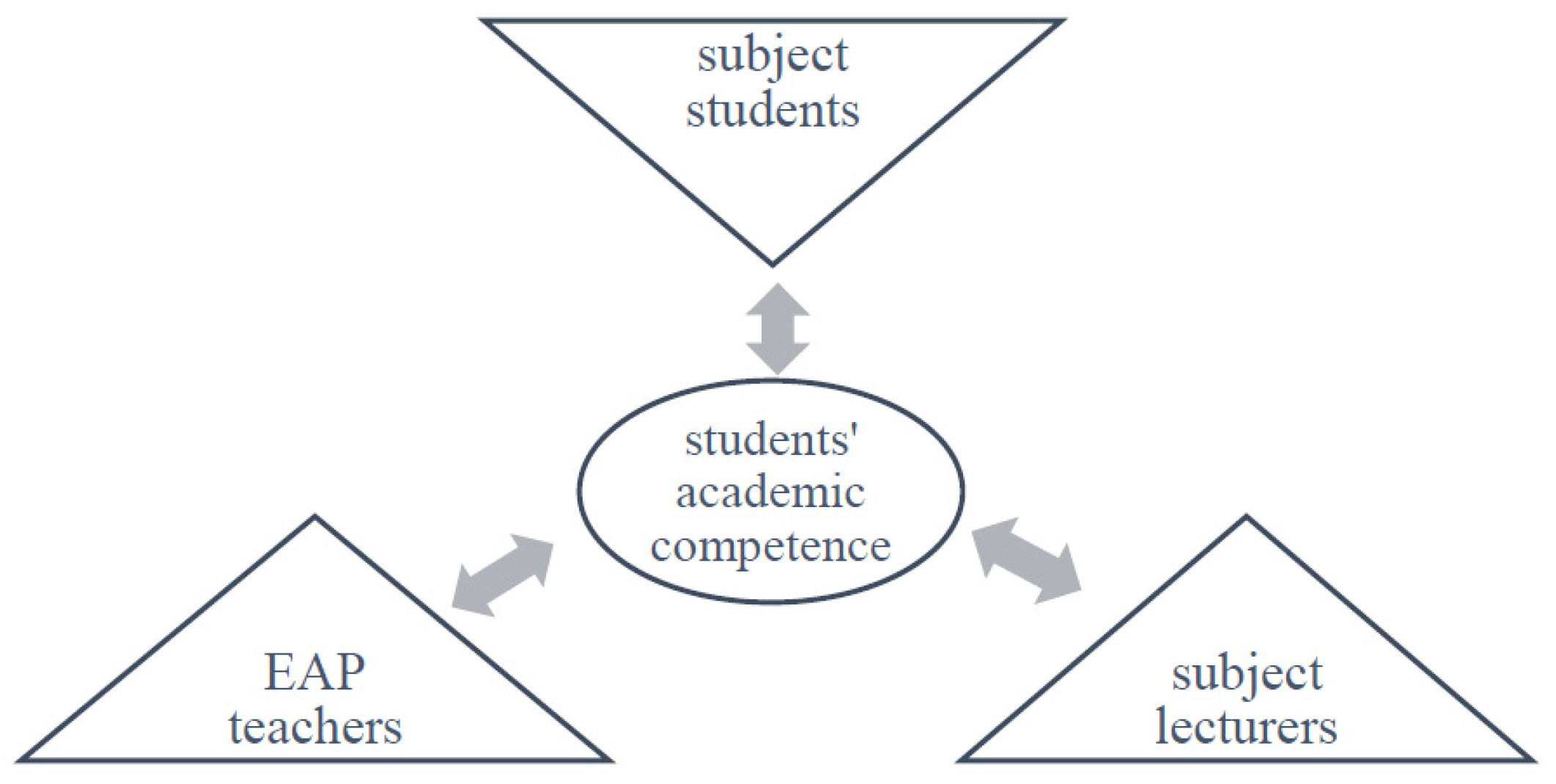Keep the Change Alive: Challenges and Chances for EAP Teacher Development Through the CHAT Lens
Abstract
1. Introduction: Lost in Transition
2. Review of Literature
2.1. Four Generations of CHAT Studies
2.2. Empirical Research on EAP Teacher Development
3. Methods
- What are the key challenges and opportunities that EAP teachers encounter in their professional development?
- How do EAP teachers negotiate their professional identity and agency within institutional and disciplinary structures?
- In what ways does the CHAT framework illuminate the contradictions and transformative learning experiences in EAP teacher development?
4. Findings and Discussions
4.1. Theorizing EAP Teacher Development Through the Framework of Expansive Learning
“We need to accept vagueness and uncertainty about the information detailed in the sample research articles because accurate understanding of the content knowledge is not the point of this course. We are the readers of students’ work, so our questions should aim at a good match of language and content in their written product. Instead of feeding them with correct answers to everything, we can raise realistic questions about students’ writing, such as, Are you trying to compare the methods used to enhance to effectiveness of something? What particular purpose does the comparison serve? Does your review eventually lead to or initiate a substantial breakthrough?”(Informal talk with the subject lecturer)
4.2. The Issue of Object: Learner Needs-Directed Activity System of TEAP
“Every masterpiece tries to tell me what my students might need or how I should teach to meet the learner’s needs. … The more I read, the more I am confused: Is learner need what I am reading in the literature or what I am targeting in the classroom?”
4.3. Internal and External Contradictions of the TEAP Activity System
5. Conclusions and Implications
Funding
Institutional Review Board Statement
Informed Consent Statement
Data Availability Statement
Acknowledgments
Conflicts of Interest
References
- Ding, A.; Bruce, I. The English for Academic Purposes Practitioner: Operating on the Edge of Academia; Springer International: Cham, Switzerland, 2017. [Google Scholar]
- Ding, A. EAP Practitioner Identity. In Specialised English: New Directions in ESP and EAP Research and Practice; Hyland, K., Wong, L.L.C., Eds.; Routledge: London, UK, 2019; pp. 63–75. [Google Scholar]
- Flowerdew, J. Power in English for Academic Purposes. In Specialised English: New Directions in ESP and EAP Research and Practice; Hyland, K., Wong, L.L.C., Eds.; Routledge: London, UK, 2019; pp. 50–62. [Google Scholar]
- Hyland, K. Sympathy for the Devil? A Defense of EAP. Lang. Teach. 2018, 51, 383–399. [Google Scholar] [CrossRef]
- Morgan, B. Fostering Transformative Practitioners for Critical EAP: Possibilities and Challenges. J. Engl. Acad. Purp. 2009, 8, 86–99. [Google Scholar]
- Engeström, Y.; Sannino, A. Studies of Expansive Learning: Foundations, Findings and Future Challenges. Educ. Res. Rev. 2010, 5, 1–24. [Google Scholar] [CrossRef]
- Engeström, Y.; Sannino, A. From Mediated Actions to Heterogenous Coalitions: Four Generations of Activity-Theoretical Studies of Work and Learning. Mind Cult. Act. 2021, 28, 4–23. [Google Scholar] [CrossRef]
- Sannino, A. Transformative Agency as Warping: How Collectives Accomplish Change Amidst Uncertainty. Pedagog. Cult. Soc. 2022, 30, 9–33. [Google Scholar]
- Engeström, Y.; Engeström, R. The Mastery of Janitorial Cleaning Work and the Workers’ Qualitative Need for Training; ServiSystems: Helsinki, Finland, 1984. [Google Scholar]
- Leont’ev, A. Activity, Consciousness, and Personality; Prentice-Hall: Englewood Cliffs, NJ, USA, 1978. [Google Scholar]
- Engeström, Y. Learning by Expanding: An Activity-Theoretical Approach to Developmental Research; Orienta-Konsultit: Helsinki, Finland, 1987. [Google Scholar]
- Engeström, Y.; Haavisto, V.; Pihlaja, J. Municipal Courts Facing a New Way of Working: An Application of Developmental Work Research in the Court System; Yliopistopaino: Helsinki, Finland, 1992. [Google Scholar]
- Engeström, Y. Weaving the Texture of School Change. J. Educ. Chang. 2008, 9, 379–383. [Google Scholar] [CrossRef]
- Engeström, Y. Expansive Learning at Work: Toward an Activity Theoretical Reconceptualization. J. Educ. Work 2001, 14, 133–156. [Google Scholar] [CrossRef]
- Hadley, G. English for Academic Purposes in Neoliberal Universities: A Critical Grounded Theory; Springer: Berlin/Heidelberg, Germany, 2015. [Google Scholar]
- Macaro, E.; Hultgren, A.K.; Kirkpatrick, A.; Lasagabaster, D. English Medium Instruction: Global Views and Countries in Focus: Introduction to the Symposium Held at the Department of Education, University of Oxford on Wednesday 4 November 2015. Lang. Teach. 2019, 52, 231–248. [Google Scholar]
- Creswell, J.W. Research Design: Qualitative, Quantitative and Mixed Methods Approaches, 4th ed.; Sage Publications Ltd.: London, UK, 2014. [Google Scholar]
- Paltridge, B.; Starfield, S. Ethnographic Perspectives on English for Academic Purposes Research. In The Routledge Handbook of English for Academic Purposes; Hyland, K., Shaw, P., Eds.; Routledge: London, UK, 2016; pp. 218–229. [Google Scholar]
- Ministry of Education of the People’s Republic of China. Guidelines for English Education in Higher Education; Higher Education Press: Beijing, China, 2022. [Google Scholar]
- Hyland, K.; Shaw, P. (Eds.) The Routledge Handbook of English for Academic Purposes; Routledge: London, UK, 2016. [Google Scholar]
- Hamp-Lyons, L. English for Academic Purposes: 2011 and beyond. J. Engl. Acad. Purp. 2011, 10, 2–4. [Google Scholar]
- Du, J.; Li, W.; Li, Q. Who Are We, What Can We Do, and What Do We Think? Review on EAP Teacher Development. Chin. J. Appl. Linguist. 2022, 45, 532–550. [Google Scholar]
- Campion, G. ‘The Learning Never Ends’: Exploring Teachers’ Views on the Transition from General English to EAP. J. Engl. Acad. Purp. 2016, 23, 59–70. [Google Scholar]







| Components | Inner Conflicts |
|---|---|
| subject | Dilemma between sustained experience in ELT and the need for a theoretical breakthrough in EAP |
| object | Tension between students’ EAP competence and teachers’ professional development |
| outcome | Disparity between the rich data collected and materials developed for teaching and the scarce articles written and accepted for publication |
| instrument | Clash between discursive knowledge and skills demanded EAP teaching and the narrowly focused EAP research |
| rules | Disparity between hourly based rewards received by EAP teachers at a regular rate and the profit and fame engendered by scholarly publication |
| division of labor | The discrepancy between EAP teachers’ discrete efforts for scholarship and researchers’ focused inquiries, as well as the different statuses of the two subject groups in the institute and the university |
| community | The polarized cultural capital of EAP teachers and researchers resulting from the post hoc vs. ad hoc socialization |
Disclaimer/Publisher’s Note: The statements, opinions and data contained in all publications are solely those of the individual author(s) and contributor(s) and not of MDPI and/or the editor(s). MDPI and/or the editor(s) disclaim responsibility for any injury to people or property resulting from any ideas, methods, instructions or products referred to in the content. |
© 2025 by the author. Licensee MDPI, Basel, Switzerland. This article is an open access article distributed under the terms and conditions of the Creative Commons Attribution (CC BY) license (https://creativecommons.org/licenses/by/4.0/).
Share and Cite
Du, J. Keep the Change Alive: Challenges and Chances for EAP Teacher Development Through the CHAT Lens. Sustainability 2025, 17, 3302. https://doi.org/10.3390/su17083302
Du J. Keep the Change Alive: Challenges and Chances for EAP Teacher Development Through the CHAT Lens. Sustainability. 2025; 17(8):3302. https://doi.org/10.3390/su17083302
Chicago/Turabian StyleDu, Jianying. 2025. "Keep the Change Alive: Challenges and Chances for EAP Teacher Development Through the CHAT Lens" Sustainability 17, no. 8: 3302. https://doi.org/10.3390/su17083302
APA StyleDu, J. (2025). Keep the Change Alive: Challenges and Chances for EAP Teacher Development Through the CHAT Lens. Sustainability, 17(8), 3302. https://doi.org/10.3390/su17083302






